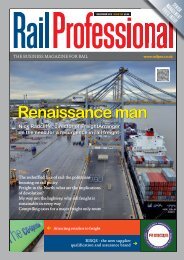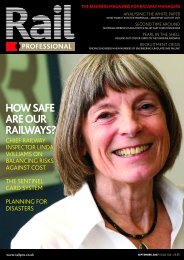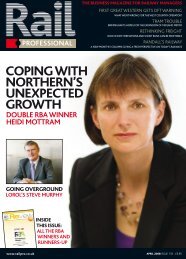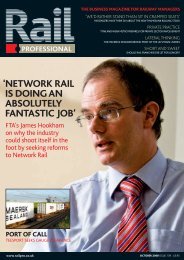View as PDF - Rail Professional
View as PDF - Rail Professional
View as PDF - Rail Professional
You also want an ePaper? Increase the reach of your titles
YUMPU automatically turns print PDFs into web optimized ePapers that Google loves.
Opinion<br />
Delivering the goods<br />
The network<br />
shapes up<br />
Funding for infr<strong>as</strong>tructure improvements is a big step in the right direction, says Chris MacRae,<br />
even if it does seem to be at odds with other freight policies<br />
In July, the FTA welcomed the government announcement<br />
of a £200m investment fund in strategic rail enhancements<br />
for England and Wales. We are delighted about the<br />
boost this will bring to the supply chain and hope, above<br />
all, that it will encourage an incre<strong>as</strong>e in modal shift.<br />
The investment is part of the High Level Output<br />
Specification (HLOS) for England and Wales and w<strong>as</strong><br />
announced by the secretary of state for transport for Control<br />
Period 5 (CP5), which runs from 2014 to 2019.<br />
The fund is intended to further develop the current work<br />
on the strategic rail freight network and provide additional<br />
investment in schemes such <strong>as</strong> the ‘electric spine’ corridor of<br />
electrification, linking Yorkshire and West Midlands to south<br />
co<strong>as</strong>t ports, benefiting freight <strong>as</strong> well <strong>as</strong> p<strong>as</strong>senger traffic.<br />
This will be accompanied by loading gauge enhancement<br />
to W12 for 9-foot 6-inch containers. Many shippers require<br />
larger containers and the additional height and width is<br />
needed if companies are going to be encouraged to make the<br />
shift to rail freight. This is also vital for the UK’s position in<br />
international trade. With international shipping containers<br />
getting taller, having a transport infr<strong>as</strong>tructure that can deal<br />
with them is vital to ensuring the UK remains a main port of<br />
call for the largest ships from the Asian trades, rather than a<br />
feeder destination from the continent, given the pressures on<br />
shipping lines to cut down the number of individual port calls<br />
within Europe.<br />
Creating the right conditions for significant private sector<br />
investment in electric freight locomotives, which offer more<br />
efficient, capable and sustainable freight haulage, is a stated<br />
desired outcome of the HLOS’s focus upon electrification. The<br />
HLOS states that ‘the rolling programme of electrification is<br />
expected to make rail freight commercially more attractive<br />
across England, supporting our growing international trade<br />
and transfer of container traffic from road’.<br />
FTA wholeheartedly supports the continuing development<br />
of Britain’s trade links and connectivity. Mode shift and<br />
the environment is a major consideration for FTA and this<br />
investment is a great step forward for both. Those wishing<br />
to make the shift must make a long-term investment and<br />
commitment and this infr<strong>as</strong>tructure investment by the<br />
government goes a long way towards encouraging others to do<br />
the same, and to leverage in the consequential private sector<br />
investment in facilities, locomotives and rolling stock<br />
to deliver this.<br />
While this infr<strong>as</strong>tructure investment by UK and Scottish<br />
governments is welcomed by the FTA, we must stress that<br />
the current Office of <strong>Rail</strong> Regulation freight track access<br />
charges consultation, mentioned in this column in August’s<br />
<strong>Rail</strong> <strong>Professional</strong>, contradicts this good news. The consultation<br />
includes a review of the variable usage charge and proposals<br />
to introduce a freight specific charge on the ‘avoidable<br />
costs’ of running freight on the network. This represents a<br />
potentially fundamental shift in previous track access charging<br />
policy away from encouraging freight growth in a context of<br />
declining track access charges for freight to help competition<br />
with road, to one of maximising the revenue that certain<br />
sectors deemed captive to rail can afford to pay.<br />
This sends seriously worrying and negative signals to<br />
private sector investment in facilities and equipment for rail<br />
freight where pay back periods are far in excess of the five-year<br />
control period review timescales. Also, the potential for change<br />
in policy mid-way through an <strong>as</strong>set’s costed life can throw out<br />
financial viability calculations.<br />
None of this is what business needs if it is to be encouraged<br />
to adopt modal shift and leverage in the consequential<br />
investment that the government wants to see from the HLOS.<br />
It is <strong>as</strong> though the government is giving with the right hand<br />
and the ORR is taking with the left. We are still urging<br />
everyone affected to fight these proposals, otherwise this good<br />
news may mean nothing and the attractiveness of rail freight<br />
will be seriously overshadowed.<br />
Chris MacRae is the rail freight policy manager at the Freight<br />
Transport Association.<br />
september 2012 Page 21

















